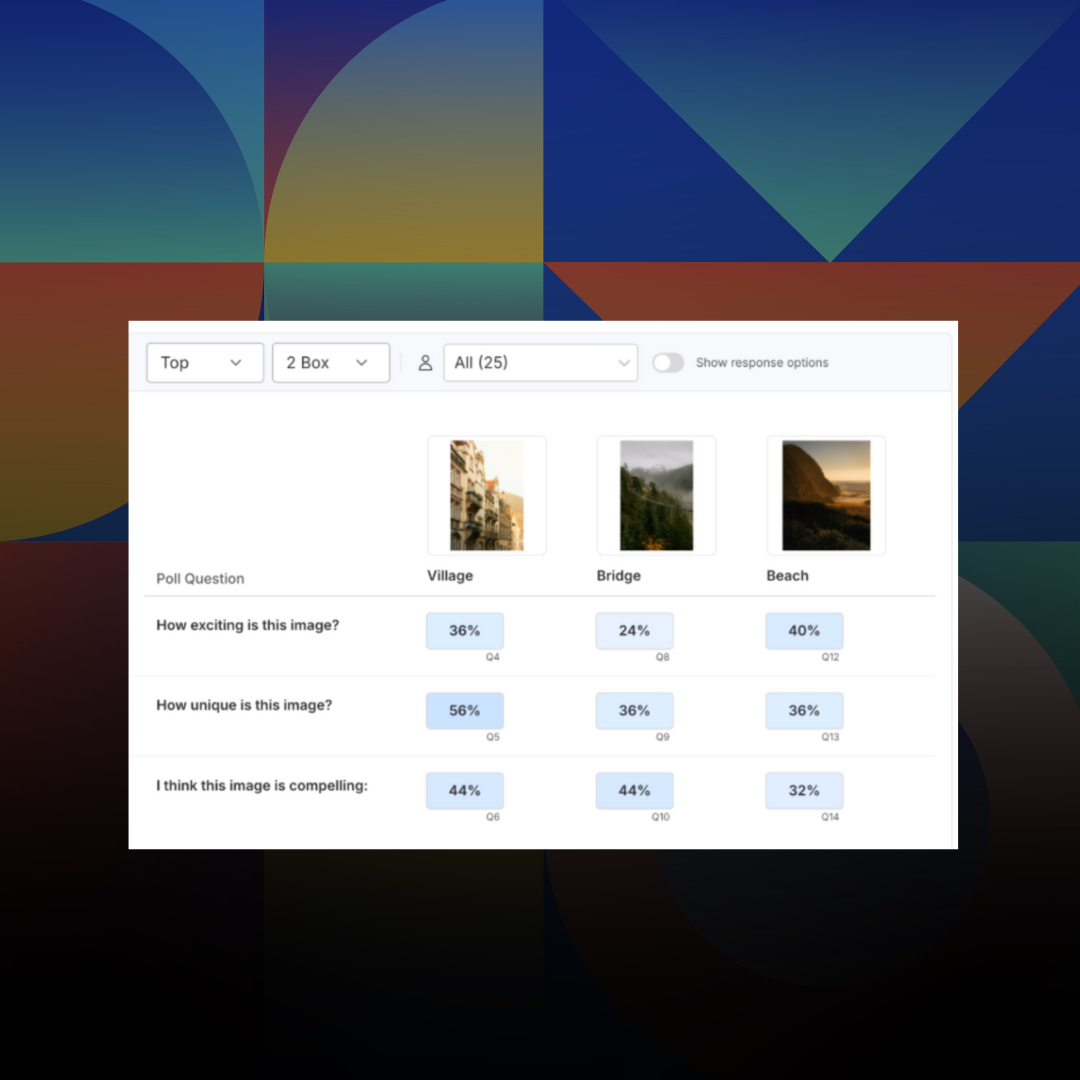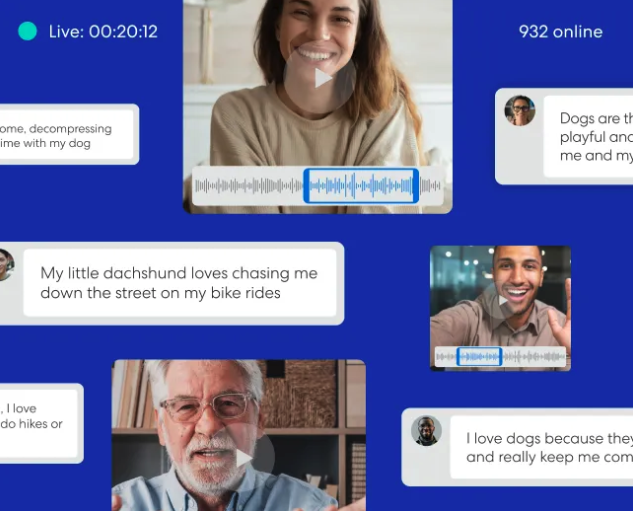
Advanced Research
The Most Cutting-Edge Consumer Insights Software of 2026
Team Remesh
January 5, 2026
Market Research
Articles

Advanced Research
The Most Cutting-Edge Consumer Insights Software of 2026
Team Remesh
January 5, 2026
Market Research
Articles

Research 101
Introducing: Poll Comparison - Streamline Concept Testing and Make Better Decisions Faster
Emmet Hennessy
November 24, 2025
Market Research
Articles

Research 101
Introducing: Poll Comparison - Streamline Concept Testing and Make Better Decisions Faster
Emmet Hennessy
November 24, 2025
Market Research
Articles

AI
Purpose-Built for Research AI is Here - a Letter from the CPO
Jessica Dubin
October 21, 2025
Market Research
Articles

AI
Purpose-Built for Research AI is Here - a Letter from the CPO
Jessica Dubin
October 21, 2025
Market Research
Articles

Advanced Research
Unlock Agile Global Insights: Using Remesh Multi-Language Conversations for Research Across Audiences
Customer Success Team
October 14, 2025
Market Research
Articles

Advanced Research
Unlock Agile Global Insights: Using Remesh Multi-Language Conversations for Research Across Audiences
Customer Success Team
October 14, 2025
Market Research
Articles

AI
The Prompt Is the New Moderator Guide
Anthony Lam
September 16, 2025
Market Research
Articles

AI
The Prompt Is the New Moderator Guide
Anthony Lam
September 16, 2025
Market Research
Articles

AI
Building an AI-Ready Research Stack: Beyond Data Preparation
Anthony Lam
September 9, 2025
Market Research
Articles

AI
Building an AI-Ready Research Stack: Beyond Data Preparation
Anthony Lam
September 9, 2025
Market Research
Articles

AI
Agentic AI for Research: A Practical Primer
Dan Reich
September 2, 2025
Market Research
Articles

AI
Agentic AI for Research: A Practical Primer
Dan Reich
September 2, 2025
Market Research
Articles
How To Improve Customer Experience Using Customer Knowledge
Insights teams should constantly iterate on and learn from customer knowledge and improve customer experiences. But, what happens after data is collected?



In order to be competitive, your team must optimize the customer experience (CX) using the primary touchpoints in your customer journey. This is the best long-term strategy for developing customer satisfaction and loyalty. If you’re reading this article, you’re probably already convinced of that strategy!
A good place to start is by developing customer knowledge, which identifies areas of improvement for both the customer relationship and personalization.

Why is Customer Knowledge Important?
For many companies, customer experience is the main axis of differentiation vis-à-vis the competition. When two companies offer similar products, it’s the customer experience that influences consumer purchasing behavior.
To improve customer experience, a company must collect customer knowledge, meaning all the information your company has about your customers or the sum of your customer data.

Each particular customer experience has an impact on the overall impression your client has of your brand. Some experiences that commonly influence customer opinion include:
- an exchange with a call center rep
- the purchase of a product on an e-commerce site
- the delivery of a product
What are the irritants and frictions in your customer journey? Your customers are more familiar with those hiccups than anyone else. So in order to collect a robust database of concerns, listen to your customers about your brand’s:
- website
- mobile experience
- physical point of sale (if applicable)
- live chat options
- social channels
- email marketing
- mobile app
So, we know that customer knowledge is an essential piece of improving customer experience and moving the dial on customer loyalty. But, what are some actions your insights team can take to make an OK experience into a great customer experience?

Chose A Model for Customer Experience
After determining how to improve the customer experience for your brand, it’s time to prioritize feedback. Some ways to attribute value to customer experience strategy improvements include:
- cost to fix
- time to fix
- effort to fix
- resources required to fix
- impact on business
- impact on customer
An improvement may not necessarily fit under all of these categories at once, but solving for at least one can lead to serious executive buy-in. In fact, CEOs who lead the charge on customer experience report much higher profitability at their companies than at competitor brands.
Use your customer knowledge data to guide your prioritization, and move forward with a customer experience strategy model.

The Harvard Business Review recommends two types of CX models: the Apostle Model, and the Loyalty-Profitability Model.
- The Apostle Model. This model segments customers according to their combined satisfaction and loyalty levels. You can measure those two items by engaging customers in online focus groups or customer feedback surveys.
- The Loyalty-Profitability Model. This model segments customers by combining loyalty levels with correlated profitability. You can measure this by combining survey or focus group results with profit and loss reports. A more innovative or agile methodology is to assume social media followers are loyal customers and to combine social metrics with profit/loss reports.
It has become very easy to understand customer expectations and needs. Don’t be a Hamlet! All your team needs to do is act.

Target and Personalize
Customers want to feel unique, which is why customization is essential to your CX strategy. Here again, customer knowledge is a condition of personalization.
For example, it’s possible to customize an email with the surname, first name, age, purchase history, professional role, content preference, and so on of your customer. If you don’t have access to this data, or if it’s not centralized, that personalization is nearly impossible.
As a culture, we’re awash with data. In fact, it’s taken just 3 years to create 90 percent of our data. That means instead of accumulating data, brands should prioritize how to organize old data, and how to take action on new information.
Some tools for customer experience and feedback organization include:
- MyFeelBack. This customer knowledge platform allows you to create and send targeted questionnaire campaigns, and integrates with your CRM to combine questionnaire data with contact information.
- Episerver. This is a content personalization tool that filters for best results over time. Not only does it recommend content based on individual user interactions with your site, but it also optimizes content recommendations based on individual behavior.
- DemandBase. This account-based marketing platform provides intent data (that means actionable insights!) through a number of features. Most notably, DemandBase provides reports on keyword intent for SEO and paid search, which can strengthen your customer knowledge database.

Summing Up Customer Knowledge
Listen to your customers, and take action. The CX industry is packed with rich data - there's no excuse to let it sit.
Still not sure how to organize your customer knowledge data? Download our eBook on innovative solutions for structuring customer data!
-
Lorem ipsum dolor sit amet, consectetur adipiscing elit. Suspendisse varius enim in eros elementum tristique. Duis cursus, mi quis viverra ornare, eros dolor interdum nulla, ut commodo diam libero vitae erat. Aenean faucibus nibh et justo cursus id rutrum lorem imperdiet. Nunc ut sem vitae risus tristique posuere.
-
Lorem ipsum dolor sit amet, consectetur adipiscing elit. Suspendisse varius enim in eros elementum tristique. Duis cursus, mi quis viverra ornare, eros dolor interdum nulla, ut commodo diam libero vitae erat. Aenean faucibus nibh et justo cursus id rutrum lorem imperdiet. Nunc ut sem vitae risus tristique posuere.
-
More


Introducing: Poll Comparison - Streamline Concept Testing and Make Better Decisions Faster

.png)

.png)
Read More

.png)
.png)
.png)

.png)

.png)
Learn More

.png)
.png)
.png)

Stay up-to date.
Stay ahead of the curve. Get it all. Or get what suits you. Our 101 material is great if you’re used to working with an agency. Are you a seasoned pro? Sign up to receive just our advanced materials.






